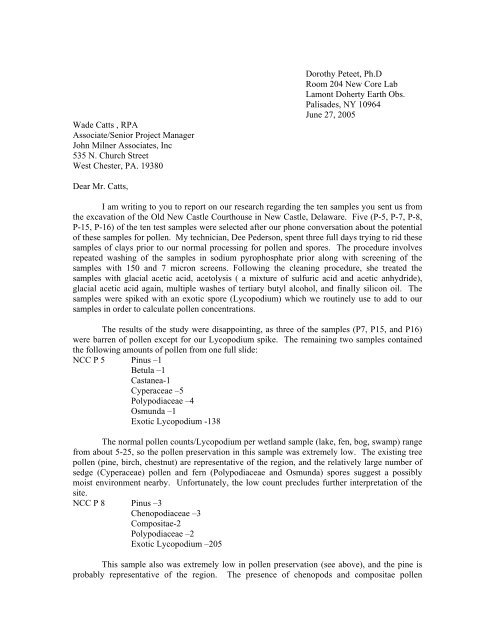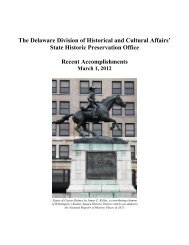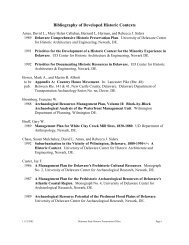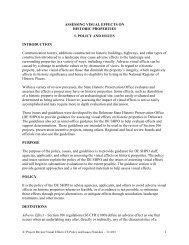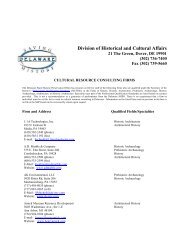Report of the Archaeological Investigations of the New Castle Court ...
Report of the Archaeological Investigations of the New Castle Court ...
Report of the Archaeological Investigations of the New Castle Court ...
You also want an ePaper? Increase the reach of your titles
YUMPU automatically turns print PDFs into web optimized ePapers that Google loves.
Wade Catts , RPA<br />
Associate/Senior Project Manager<br />
John Milner Associates, Inc<br />
535 N. Church Street<br />
West Chester, PA. 19380<br />
Dear Mr. Catts,<br />
Dorothy Peteet, Ph.D<br />
Room 204 <strong>New</strong> Core Lab<br />
Lamont Doherty Earth Obs.<br />
Palisades, NY 10964<br />
June 27, 2005<br />
I am writing to you to report on our research regarding <strong>the</strong> ten samples you sent us from<br />
<strong>the</strong> excavation <strong>of</strong> <strong>the</strong> Old <strong>New</strong> <strong>Castle</strong> <strong>Court</strong>house in <strong>New</strong> <strong>Castle</strong>, Delaware. Five (P-5, P-7, P-8,<br />
P-15, P-16) <strong>of</strong> <strong>the</strong> ten test samples were selected after our phone conversation about <strong>the</strong> potential<br />
<strong>of</strong> <strong>the</strong>se samples for pollen. My technician, Dee Pederson, spent three full days trying to rid <strong>the</strong>se<br />
samples <strong>of</strong> clays prior to our normal processing for pollen and spores. The procedure involves<br />
repeated washing <strong>of</strong> <strong>the</strong> samples in sodium pyrophosphate prior along with screening <strong>of</strong> <strong>the</strong><br />
samples with 150 and 7 micron screens. Following <strong>the</strong> cleaning procedure, she treated <strong>the</strong><br />
samples with glacial acetic acid, acetolysis ( a mixture <strong>of</strong> sulfuric acid and acetic anhydride),<br />
glacial acetic acid again, multiple washes <strong>of</strong> tertiary butyl alcohol, and finally silicon oil. The<br />
samples were spiked with an exotic spore (Lycopodium) which we routinely use to add to our<br />
samples in order to calculate pollen concentrations.<br />
The results <strong>of</strong> <strong>the</strong> study were disappointing, as three <strong>of</strong> <strong>the</strong> samples (P7, P15, and P16)<br />
were barren <strong>of</strong> pollen except for our Lycopodium spike. The remaining two samples contained<br />
<strong>the</strong> following amounts <strong>of</strong> pollen from one full slide:<br />
NCC P 5 Pinus –1<br />
Betula –1<br />
Castanea-1<br />
Cyperaceae –5<br />
Polypodiaceae –4<br />
Osmunda –1<br />
Exotic Lycopodium -138<br />
The normal pollen counts/Lycopodium per wetland sample (lake, fen, bog, swamp) range<br />
from about 5-25, so <strong>the</strong> pollen preservation in this sample was extremely low. The existing tree<br />
pollen (pine, birch, chestnut) are representative <strong>of</strong> <strong>the</strong> region, and <strong>the</strong> relatively large number <strong>of</strong><br />
sedge (Cyperaceae) pollen and fern (Polypodiaceae and Osmunda) spores suggest a possibly<br />
moist environment nearby. Unfortunately, <strong>the</strong> low count precludes fur<strong>the</strong>r interpretation <strong>of</strong> <strong>the</strong><br />
site.<br />
NCC P 8 Pinus –3<br />
Chenopodiaceae –3<br />
Compositae-2<br />
Polypodiaceae –2<br />
Exotic Lycopodium –205<br />
This sample also was extremely low in pollen preservation (see above), and <strong>the</strong> pine is<br />
probably representative <strong>of</strong> <strong>the</strong> region. The presence <strong>of</strong> chenopods and compositae pollen


